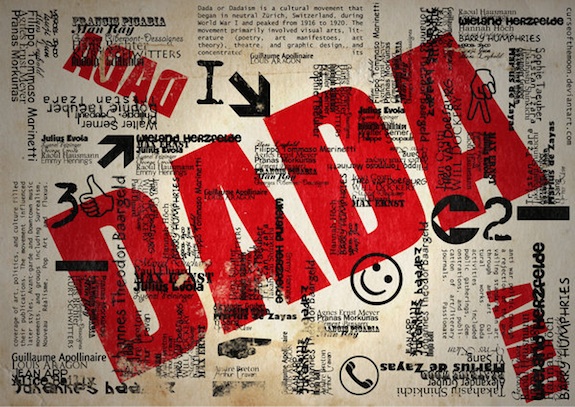The Dada movement originated from Zurich by poets
and artists that was a direct reaction towards all of the propaganda and
slaughter during the events of World War 1. The style shocked everyone with its
unique simplicity. The style quickly spread to many other countries as well.
The artists didn't share a universal style but they shared some similar
concepts. This anti-art movement consisted or art that rejected idealism, and
wanted to represent the direct opposite of what art meant. Dada in addition as
wanted to ignore aesthetics as well to further increase its rebellious style.
Dada style was commonly represented with typographic styles or printed images.
Many of these images didn't have any meaning what so ever as well; they were
all dependent on the viewer’s point of view. After The First World War, many artists
or designers that participated during this movement, started to practice
surrealism. In contrast to the Dada movement, surrealism consisted of images
and writings that usually depicted illogical and strange looking scenes that
expressed the artist’s idea.
Today Dadaism and Surrealism is still found among
us. The style is commonly found in gravity because of its rebellious nature.
Some modern fashion trends also originated from Dadaism such as punk fashion.
Dadaism is commonly found in the graphic design area as well. For example of
this contempory Dadaism, one could look at “Nu Bodies” by Edward Fella.
Small Dada Evening by Kurt Schwitters 1923
 This poster consisted
of a lot of jumbled typography written on top of each other and some small
images of hands, a deer’s head and an arrow. Bold red letters that spell “DADA”
and written in various rotations as well. The poster has an asymmetrical
balance between the size of the typography and colour. The thickness and the
red colour of the letters that spell DADA all help the viewer to easily read
these. They also help to make the poster to look somewhat more attractive to
the eye as well. Since not all letters are written with the same font style,
this breaks repetition and in my opinion makes the poster more interesting to
look at as well.
This poster consisted
of a lot of jumbled typography written on top of each other and some small
images of hands, a deer’s head and an arrow. Bold red letters that spell “DADA”
and written in various rotations as well. The poster has an asymmetrical
balance between the size of the typography and colour. The thickness and the
red colour of the letters that spell DADA all help the viewer to easily read
these. They also help to make the poster to look somewhat more attractive to
the eye as well. Since not all letters are written with the same font style,
this breaks repetition and in my opinion makes the poster more interesting to
look at as well.References
1.) Linotype, Dadaism, Available from: http://www.linotype.com/786-18052/thedadamovementtoday.html, [20 November 2014]
2.) Oxford Art Online, Dada and Surrealism, Available from: http://www.oxfordartonline.com/public/page/themes/dadaandsurrealis, [20 November]
3.) Fella, 2010, Graphic Design and Postmodernism, September 3 2010, DCAIGA, Available from: http://dcaiga.blogspot.com/2010/09/graphic-design-and-postmodernismedward.html, [20 Novemeber 2014]
4.) Moma, Kleine Dada Soiree, Available from: http://www.moma.org/learn/moma_learning/2562-2, [20 November 2014]
